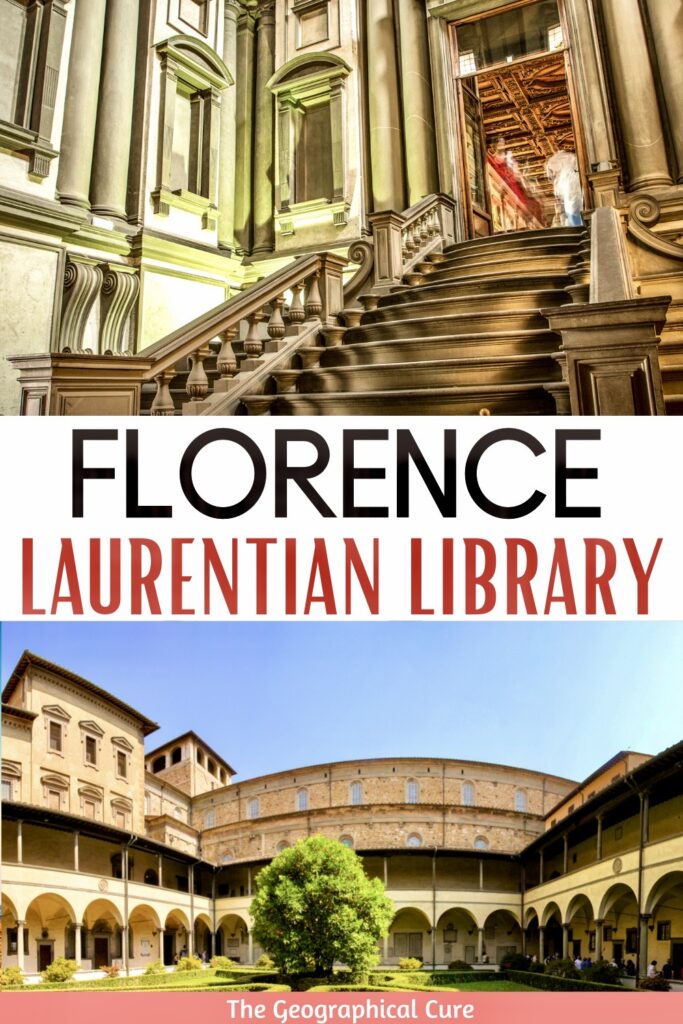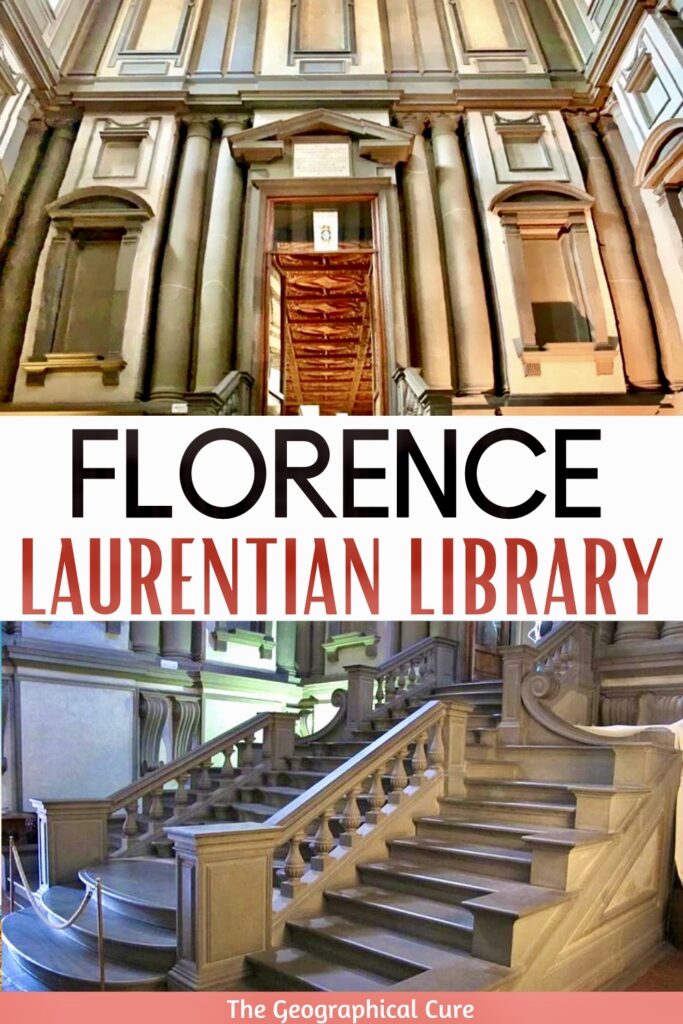Looking for something unusual to do in Florence? Visit the Laurentian Library! Michelangelo designed the revolutionary library, and it’s one of the most radical buildings in architectural history.
In 1515, Pope Clement VIII commissioned Michelangelo to design the new structure. As a member of the powerful Medici family, the pope wanted to create something spectacular that would rival the Vatican Library.
Overview Of The Laurentian Library
The Laurentian Library is part of the Basilica of San Lorenzo complex in Florence. The basilica was the Medici’s parish church.
Situating the library in such an important place reflected the prestige handmade books held in Florentine culture.
Construction of the library began in 1524. But there were various interruptions and the library didn’t open until 1571. At the time, it was a resounding architectural triumph and considered a masterpiece of Mannerism.
The library was built on the second floor of the western side of the cloister of San Lorenzo on top of the existing convent.
This was intentional. It was important to protect the precious books from flooding. Plus, Michelangelo didn’t want to build a structure on the piazza because it would compete with the church itself.
The library consists of a a 48 foot vestibule with a monumental staircase and a reading room. It has one of the world’s most important collections of antique manuscripts and books, which were assembled by Cosimo the Elder de Medici and Lorenzo the Magnificent de Medici.
It now functions as a heritage museum, not a library.
READ: History of the Medici Family
Michelangelo’s Mannerist Architecture
You may not know that Michelangelo wasn’t just a painter and sculptor. He was also an architect who devoted much of his career to that calling. For 18 years, he was even the chief architect of St. Peter’s Basilica in Rome.
In designing the library, Michelangelo broke away from classical traditions and rules of proportion. As far as he was concerned, rules were meant to be broken.
And break them he did. Michelangelo manipulated space, shadow, and light. He distorted and shifted traditional architectural elements, designing dream-like spaces with curves and unusual configurations.
Michelangelo’s dramatic and inventive architectural style marked the beginning of Mannerism, a late Renaissance period that reinvented and put a stylized twist on classicism.
Michelangelo designed the Laurentian Library after having completed the Medici Chapels. He died before it was completed. His design was implemented by Florentine architects Bartolomeo Ammannati and Giorgio Vasari.
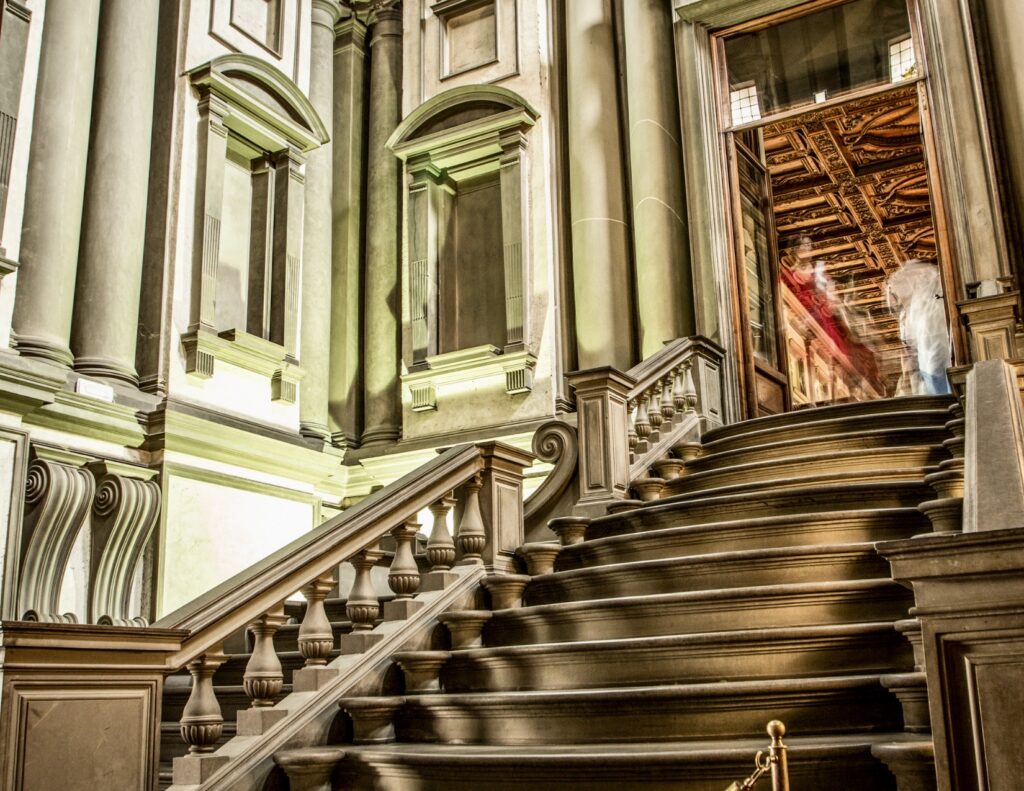
Guide To The Laurentian Library: What To See
Here are the highlights of Michelangelo’s Laurentian Library.
Staircase
The Triple Staircase may be the most striking example of Michelangelo’s Mannerist architecture. He claimed the design came to him in a dream.
It was the first freestanding staircase in European architecture. It’s massive. When you walk into the entryway and see it, you may feel almost, well, almost violated by its scale.
The oversize staircase conveys a sense of movement and momentum. Photography doesn’t do it justice. It’s has an organic quality that seems to pour forward like pools of liquid or lava.
Although Michelangelo wanted to use walnut to create it, it’s made of a gray stone called pietra serena. There are three flights of steps. There is a central stairway and two lateral stairways.
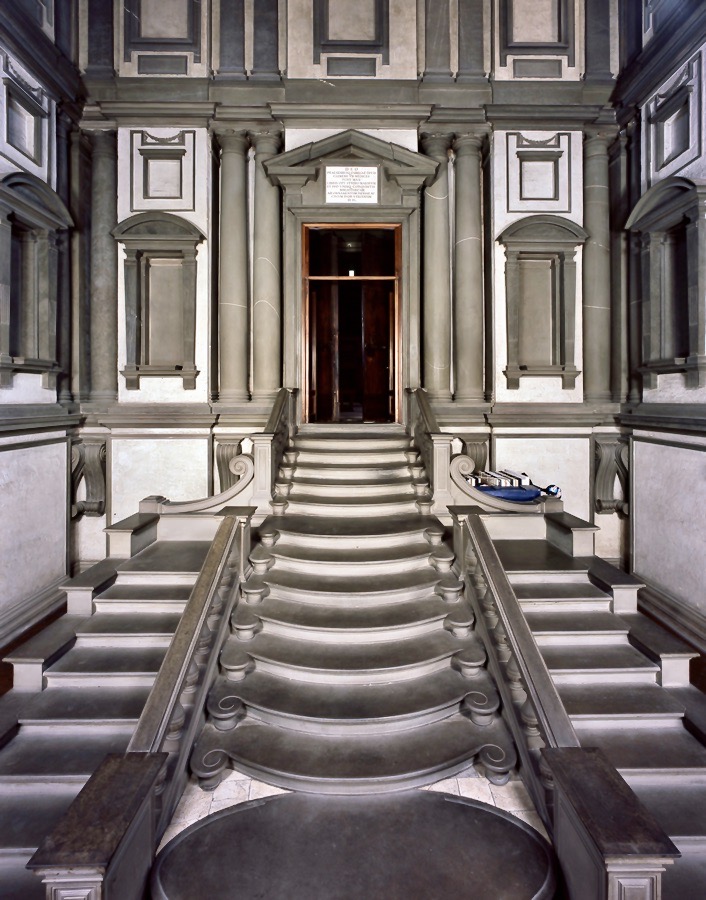
It’s unclear when you look at it where you are supposed to ascend and descend.
Michelangelo said the central stairs were for the lords and aristocracy. But when I looked at it, it seems more natural to ascend via the lateral stairways and descend through the central one.
The central staircase consists of a series of ovals. The last three steps are completely elliptical.
The steps of the side stairways are rectilinear. There are no balustrades on the side, prompting some unease and guaranteeing you’ll pay attention to the architecture itself.
At the top, the two sides are bookended with a volute, a curvilinear architecture element. But Michelangelo turns it upside down.
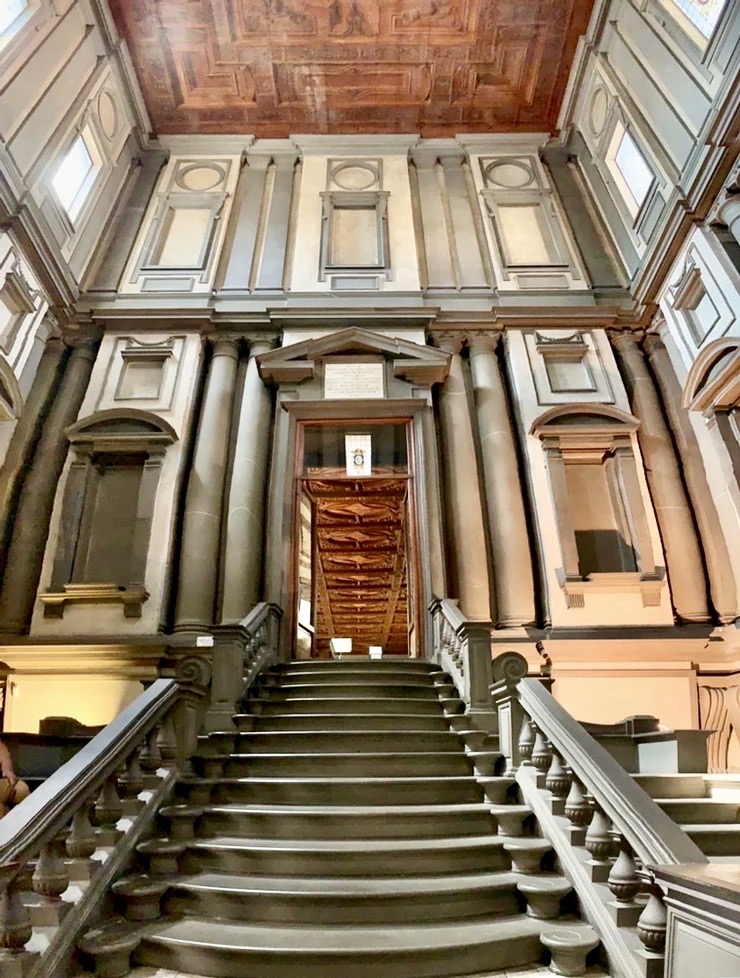
Vestibule
The Vestibule is the room welcoming you into the library. It’s known as the ricetto. The Vestibule is not a utilitarian space; Michelangelo was focused on aesthetic appeal.
The room is a square. It’s very tall, 48 feet high. This was to let in more light.
Wild structures surround the staircase. You almost don’t really see the walls. They’re decorated with architectural elements, such as extremely large low-hanging brackets that are purely decorative.
Michelangelo has also repurposed columns, which normally adorn exterior facades and serve a support function. Instead, the artist brought them inside and paired them. This challenges your idea what what a wall should look like.
The columns are recessed into the wall and at the corners. They appear to rest on corbels. Oddly, they taper down instead of tapering up.
It’s unclear why the columns are recessed. They look rather wacky in the corners, as if they’re sculptures.
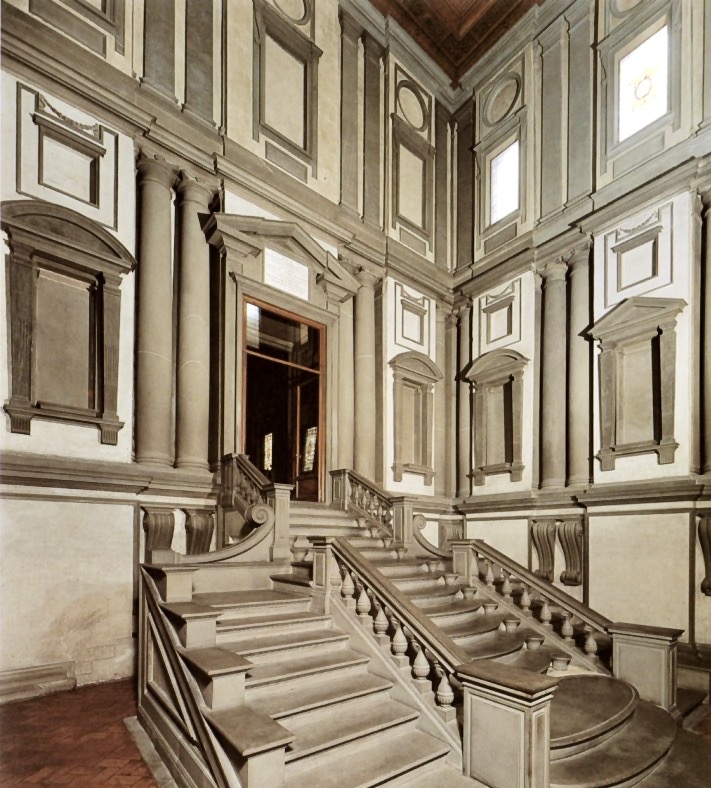
And what is between the columns? It’s ambiguous. Is it an empty niche or a blind window?
Michelangelo had no intention of filling the niches. Rather, the niches themselves are the “art.”
At the top, rectangular windows let in light and are separated by pairs of pilasters. They’re topped by roundels, which are also empty of any of the usual sculpture or carved relief.
The brackets that should hold windows are likewise out of place and separated from the “window” they usually support.
The door to the reading room is topped with a broken pediment. The pediment then oddly overlaps the columns. Michelangelo is breaking rules just for the sheer fun of defiance.
Reading Room
The elegant Reading Room is a stark contrast to the drama of the stone space below. It’s a calming horizontal room dominated by walnut wood.
It’s a rectangular space that’s over 150 feet long. There’s no focal point in the room. It just goes on and on in unending and rhythmic fashion.
There are two series of wooden benches, called plutei, separated by a central aisle. The furniture was designed by Michelangelo.
There’s a white and red terra cotta floor with 15 rectangular floor panels. They have some odd motifs, including an antelope skull. The carved wood ceiling above reflects the floor design.
The floor is original, over 500 years old. There’s a carpet that you are supposed to walk along to help preserve the floor.
Along each side you’ll see beautiful painted glass windows designed by Giorgio Vasari. They are filled with grotesque motifs, arms, and emblems, including the Medici family seal and Medici images like the turtle of Cosimo I. Like the Vestibule, the windows are separated by pietra serena pilasters.
Years ago, books were chained to the carved lecterns (reading stands) of the desks. Today, they are stored in special vaults.
Practical Guide For Visiting The Laurentian Library
Here are some must know tips for visiting.
Address: Piazza San Lorenzo 9. You enter the library from the cloisters of the Basilica of San Lorenzo.
Tickets: The Laurentian Library has separate hours and admission from the Basilica of San Lorenzo. The ticket price is 4 euros, 3.50 if you buy a combined ticket with the basilica.
Opening Hours:
Right now, the Laurentian Library is closed to the public and the website says it will re-open soon.
Previously, the library had tricky and fluctuating opening hours. It was only open only from 9:30 am to 1:00 pm from Monday through Friday, with closings for weekends, holidays, and restorations in August.
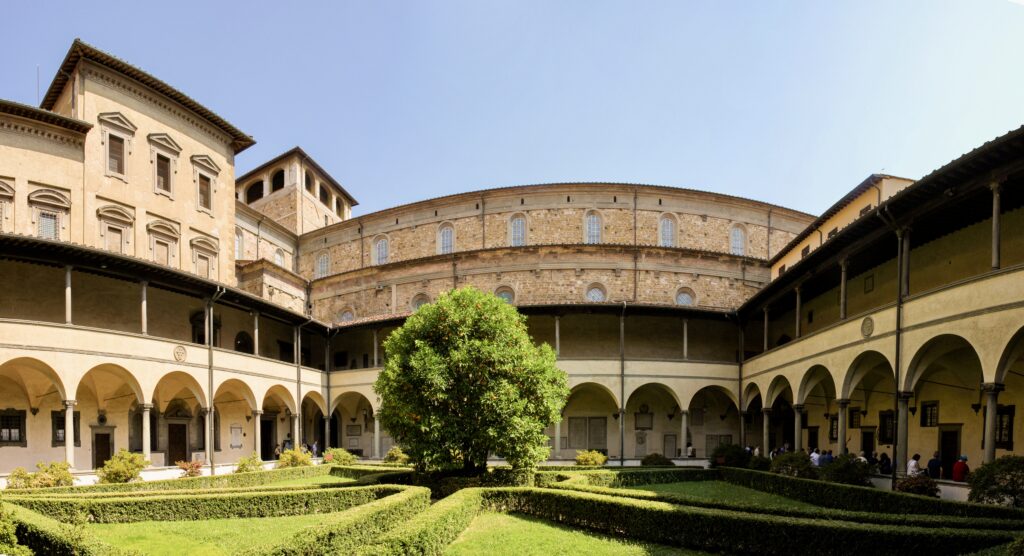
You best chance to visit is when a special exhibition is taking place. That’s when I visited last September.
I hope you’ve enjoyed my guide to the Laurentian Library. You may enjoy these other Florence travel guides and resources:
- 1 Day itinerary for Florence
- 2 Day Itinerary for Florence
- 3 Day Itinerary for Florence
- Guide to Florence’s Best Museums
- Guide To Florence’s Best Churches
- Florence Art Bucket List
- Hidden Gems in Florence
- Best Views in Florence
- Best Day trips From Florence
- Free Things To Do in Florence
- Guide to the Piazza della Signoria
If you need a guide to the Laurentian Library, pin it for later.

